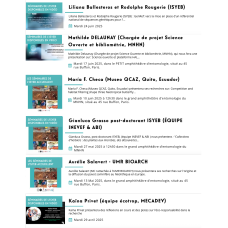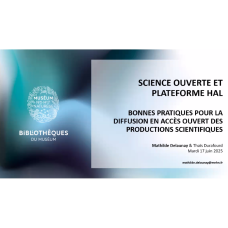Neha MEHTA, chercheuse post-doctorante à l’IMPMC (Institut de Minéralogie, de Physique des Matériaux et de Cosmochimie)

ISYEB

ISYEB
Neha MEHTA, chercheuse post-doctorante à l’IMPMC (Institut de Minéralogie, de Physique des Matériaux et de Cosmochimie), Paris, présente ses travaux de recherche.
Biogenic amorphous calcium carbonate (ACC) was first documented in eukaryotes, where ACC acts as a precursor phase for the formation of calcite and aragonite in skeletal architectures. Recent studies have shown that prokaryotes are also capable of forming intracellular ACC. Some examples include the large uncultured sulfur bacterium Achromatium oxaliferum, a magnetotactic bacterium affiliated to Alphaproteobacteria, and several cyanobacteria species associated with at least 9 genera. Unlike pure abiogenic ACC that rapidly transforms to crystalline polymorphs, ACC found in prokaryotes remains stabilized intracellularly with no obvious spontaneous transformation to crystalline phases. However, the mechanisms underlying such stability of ACC remain unknown. The role of organic or inorganic additives and/or the role of confinement of ACC within small volumes, have been discussed in stabilizing ACC.
Here, we present the application of two spectroscopy techniques (ssNMR, FTIR), to characterize intracellular ACC formed by cyanobacteria. These techniques offer a unique advantage to study intact cells without any prior treatment and thus help preserve intracellular amorphous phases, that otherwise may be lost and/or transformed during sample preparation. Using solid-state NMR (ssNMR) spectroscopy, we probe the chemical environment of CO32-, and Ca2+ within cyanobacterial ACC to gain insight into the ACC stabilization mechanisms. Our results identified ACC by its carbonate resonance at 169 ppm in the 13C-cross polarization (CP) spectrum of the intact cyanobacteria cell. Based on 2D 1H-13C NMR experiments, we also describe the chemical environment of the proton and carbon in proximity to ACC. Using 13C-31P REDOR NMR experiments, we discuss the role of P in stabilizing prokaryotic ACC.
In the second part of the work, we characterized intracellular ACC in cyanobacteria using FTIR spectroscopy. We find bands at ~860 cm-1 and ~300 cm-1 (characteristic of ACC) free of interference from organics and only present in ACC forming cyanobacteria.
We discuss the relevance of this finding regarding the detection of ACC-forming prokaryotes in natural samples. Altogether, our findings provide the first mechanistic clues about the stability of prokaryotic ACC and highlight the importance of spectroscopy techniques for studying biogenic amorphous phases.
La présentation a été enregistrée sur Teams



